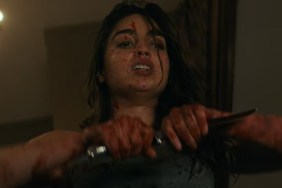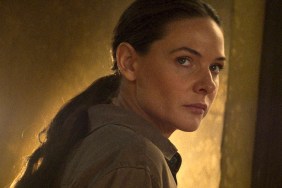The Tale of Two Sisters remake

We’re on Bowen Island, just off of Vancouver, British Columbia in a very balmy and gorgeous August 2007 to visit the set of the American version of A Tale of Two Sisters called The Uninvited. The original 2003 Korean film, a bloody and confusing pseudo-fairytale about nightmarish family relations and a young girl terrified by her new stepmother, was directed by Ji-Woon Kim and was a sensation among J and Asian horror fans in the Western World.
The secluded island is the perfect place to shoot a horror film. The roads are narrow and unlit by light posts, the houses are few and far between. And the mansion in which The Uninvited is being shot by brothers Thomas and Charles Guard is an amazingly large and fascinating one that has been completely gone over by art director Andrew Menzies (What Lies Beneath, 3:10 to Yuma) with a fine-tooth comb to make the perfect setting for this disturbing story.
Among the meadow lawns and blooming flowers hovers a film crew busily working on seemingly unknown tasks, while actresses Arielle Kebbel (The Grudge 2) and Emily Browning (Ghost Ship) lounge in chairs in comfortable shorts and t-shirts, eager to talk about their film. The directors Charles and Thomas, two young-ish Brits who are making their first film for American audiences, the producer Walter F. Parkes, sit nearby. Actress Elizabeth Banks (Slither) and actor David Strathairn (Dolores Claiborne) casually hang out nearby.
Waves crash on the nearby private beach that is the culmination of rocky goat paths covered in thousands of wildflowers. It’s a stunningly beautiful place and doesn’t at all call up feelings of fear.
Producer Walter F. Parkes (former head of DreamWorks and producer of Lemony Snickett) wanted to make A Tale of Two Sisters because he saw how hot the Asian remake trend was becoming with American audiences.
Walter Parkes: I got a phone call from an executive at Dreamworks named Mark Sourian five years ago or six years ago who called me and said, “I just saw the scariest movie I’ve ever seen. You need to see this.” Something called The Ring. So, he brought over the videotape and we popped it in. I’ll never forget we’re watching it, mesmerized and our two quite young children at the time, nine and 12, looked in and saw what we’re seeing and watched for about two minutes and got freaked out and left, which was a good sign. We bought the rights to The Ring right there. So, with the acquisition of The Ring and the success of The Ring, it kind of began a relationship we had with certain Japanese distributors and it made us quite interested in the whole subject genre of Asian horror. Subsequently, there were a number of movies made in Hollywood that certainly benefited from the success of The Ring, including The Ring Two. It was probably three years after that, I got another phone call from Mark and I have now learned to take those phone calls rather seriously. And he told me that the basic premise of the movie is this fairy tale about two girls.
Walter agreed to buy the rights to the film without even viewing it. But because of his deep understanding of how Asian horror appealed to audiences, and his desire to jump on the bandwagon, he knew it was the right idea. After all, he had just produced The Ring with monumental success.
Parkes: Japanese horror films tend to have kind of simple and very organic myths underneath them. And this is a case in point. There’s a stepmother in the story and it actually has some connection to Hamlet, it has to do with the ghost of a dead parent coming back and saying, avenge my death. So, the bones of the story were fascinating to us. And literally based on hearing the story, we said yes, go ahead. We’d buy this thing. And it was a very, very costly purchase because this was now when the Asian horror cycle was at its peak in Hollywood. So, everyone was trying to scramble go get this. And we worked for quite a long time on the screenplay. It’s a very, very difficult screenplay because there are multiple stories going on that the audience isn’t even necessarily aware of. That’s what so fascinating about it. And part of our job in trying to translate movies like this to American audience is to clarify the narrative substantially so that it’s understandable to the Western audience, but not lose that certain edge of ambiguity that makes Asian cinema really fascinating. The Ring was as difficult ’cause The Ring had its hard, very simple and fun pop concept about this videotape.

When he made Lemony Snickett, he discovered an actress named Emily Browning. She also had a brief appearance in the horror film Darkness Falls as a young Emma Caulfield in 2003. Walter knew immediately that he wanted to work with Browning again when they were ready to cast The Uninvited.
Parkes: We did say to ourselves, and said to her – she was then 13 or 14 – “You know, you should do a thriller.” Emily hadn’t been working much. She stopped working and went back to high school. So it was a little bit of fortuitous timing that she was available when we had this part.
Charles Guard: We were really knocked out by her and she caught our eye then. We really wanted to work with her for a while.
Walter admits that the main audience for this film is teenagers. He and the directors claim that they have toned down the gore from the original version, but not necessarily the horror. It was shot as a PG-13.
Parkes: Emily’s character, Anna is returning from a sanitarium because she had an emotional breakdown following the accidental death of her mother a year ago. When she returns, there starts to be certain supernatural science that it maybe wasn’t an accident. There’s also a big not-supernatural side in that. Her mother’s former nurse is now shacked up with her dad. So, these issues of seeing your parents for what they really are…you’re young, coming-of-age sexually, breaking from family, all those things, the kind of emotional issues of the movie are very much that of teenagers. You don’t want to keep teenagers out of the theater.
Charles: No one’s intention has been to go and make this a kind of slasher-style horror. It’s always been a kind of a classier end of the spectrum.
Charles and Thomas Guard, two virtually unknown directors, were hired to shoot The Uninvited based on some small commercials they had made in Europe. The film is set in the summertime countryside of Maine, and the character played by David Strathairn is named Steven, and is a novelist. Sounds like an ode to Stephen King. The storyline takes place entirely in a sprawling mansion from the point of view of Anna (Emily Browning), a troubled teenager.
Thomas Guard: I like the romanticism of the story of the two girls very much in the original. And we like the idea that kind of a horror film that was told through the perspective of this young girl. In terms of the gothic, I don’t know. I mean, gothic is quite hard to kind place now.
The brooding mansion itself becomes an important character. It has a gothic staircase that grabs your attention immediately, surrounded by vivid wallpaper. A huge courtyard and vast basement space make the house an amazing contrast of light and dark. Walter stands at the top of the staircase directing our attention to the incredibly gorgeous details the film crew added to the interior.
Parkes: I would say that 75 percent of the story takes place at the house. At any given moment there’s some element that if you didn’t get that element, you couldn’t make a movie.
Charles: The film is set in the summer. So, what we tried to do is kind of invert the horror. Normally, these kind of films take place a lot at night and everything is dark, and it’s a scary, dark house. What we’ve tried to do is keep the exterior, a lot of the scenes outside, incredibly bright and sunny. And so, the feeling inside has become a house that is the height of summer, big house.
Parkes: We went all over America. We went all over Canada. The new, bigger houses are not right for the story. And, I mean, we literally did scouts in New Zealand. We sent scouts looking all over the world. We got a couple of choices in Shreveport, Louisiana, where we might be right now. And it just didn’t look right. I’ve never found a place that is so perfect for a movie, so evocative, to suggest the family is both welcoming and kind of forbidding. It sits on this promontory on this bay that you could be in Scotland. I can’t over-hype it. It worked perfectly. It just worked perfectly. And yes, it very much suggests the dream house of a family. Hopefully, at times, it’s emotional and scary, something’s gone terribly wrong there.

And Tom and Charlie quickly said, one of the most fundamental kinds of, aspects of the language of horror is a staircase. Andrew Menzies, the art director, spent agonizing hours on the meticulous details of the house.
Andrew Menzies: I just spend, literally, weeks going through thousands and thousands of wallpapers and things that would give them the depth that they wanted from the house. ‘Cause a lot of the wallpapers have translucent qualities like the gold and stuff. And that’s what we wanted to try and tell – that depth of the 25 years that they’ve lived in this house.
The reason for this eye for detail is because Menzies found it important to recreate some of details of the original film’s production design.
Menzies: What I mean is the original film had a lot of wallpapers. And even individual walls within a room changed from different wallpapers. Because the guys were very influenced by that and that’s why they emphasize wallpapers. The entry hall is very rich gold and rose wallpaper. We try to keep it as wild as possible, so it wasn’t a typical repeat pattern. The gold gave extra depth. The first time you see the house – when you walk in – what we wanted was it to be warm and welcoming but also tell it’s got the roses and it’s feminine, and it’s the mother and the family. We didn’t want to get too gothic. I think there’s a danger with certain types of light fixtures and wallpapers to get too spooky. That was a line we really try to avoid, that we didn’t want to make it too gothic. Hopefully we have achieved that. The wallpaper in the master bedroom has a fiery filter. The girls’ bedrooms that we’re building on stage have wallpapers that are quite literal to the characters. Like Anna’s is very innocent and floral and sweet, whilst Alex has more depth and is more complex and dark. So, there are literal interpretations to the wallpaper.
Parkes: We also tried to create interesting textures. This is actually a new rug to kind of suggest that the kids have been tramping up and down these stairs for the last 15 years. These small details are really, really important.
David Strathairn: It’s very interesting that the script is quite an interior landscape because of Anna’s journey and what each character is having to navigate because of the event. It’s an interesting contrast that has this extraordinary landscape around what is an interior journey of the characters. I think that’ll probably add context for the audience when they see that it is an isolated place. But as far as our work is concerned, it’s so interior but very often the environment doesn’t come into play.
A stunning two-story boathouse was built on the property overlooking the water just for several scenes. The cold water is rough and unappealing; it is a greenish-gray that crashes constantly and does not invite swimming.
Parkes: A key part of the story is that Anna, the character that Emily plays, comes home after her mother, a year before, had died in a mysterious fire in a studio on top of the boathouse, a mother who’d been ill and had been moved out here with a caretaker. So, we looked far and wide for a property with a boathouse. We realized that wasn’t going to happen, so we built this boathouse. We really tried to evoke that kind of lazy sense of summer, which isn’t necessarily so easy in British Columbia, even in the summer. But we got plenty of beautiful sunny days. There’s a key scene in here where Anna, at the end of the first act, comes down and hears a sound, which is she associates with her mother. And it brings her back down to this place, which the father has rebuilt as if almost making believe this tragedy didn’t happen. She experiences a vision with a kind of spirit or ghost of her mother, and it’s very frightening scene. We built this here for the exteriors and we did the ghost sequence interiors on stage.
The cast and crew have some serious opinions on whether the film is close to the original, or far away from it, and how they all attempted to make it the way they thought it should be.
Charles: In the original, there’s the sisters, there’s a strange relationship between the sisters. And there’s a lot of kind of change, crossover, that they switch around a lot in terms of who the narrative is being through. Ours was kind of purer than that. It’s straighter than that. It’s very much Anna’s story, and Alex, the older sister, is very much the strong one in the relationship.
Thomas: It’s a story that has, in Korea, been told time and time again and been constantly reinterpreted.

Elizabeth Banks: [The remake is] more in line frankly with the original. I mean, the original is so visually arresting. And I think they’re really trying to go for something that American audiences can relate to but that still has a great sense of artistry about it. I do love to see a good Asian horror movie every once in a while. [Slither director] James Gunn introduced me to a lot of them. This is actually his favorite movie. So, when I told him I was doing the remake, he was horrified.
Emily Browning: Yeah. There are a few things that we had to take from the original movie and do similar. But at the same time, we didn’t, we’re not making the same film in an English version, do you know what I mean? Because the original film is awesome. It’s really excellent. And I know it has a huge fan base. So, we’re not trying to make the same film again. We have taken a lot of elements from it. I think this is a different than a lot of the Asian remakes, definitely.
Arielle Kebbel: This reminded me, when I read it, of The Hand That Rocks The Cradle or What Lies Beneath where you have those thrilling moments where it sort of takes your breath away.
Browning: I watched it just after I read the original script ages ago and I really liked it. I think it was like really beautifully shot and really cool but so confusing. I see why there’s room for a remake. We’re trying to do it without dumbing it down too much. With the first one, I have to actually take breaks from it and just collect myself and figure out what was going on because it’s really confusing. I guess that’s why the remake is happening. There’s flashback stuff and there’s weird stuff but it’s not as scattered as the other one.
Thomas: We’re very influenced by Asian terror, but we kind of just see it through our sensibilities. We don’t feel that we’re moving away from it too much. It’s very implied. A lot of it is in the faces of the characters and the anticipation of things. And we’re really into that. We hope that there’ll be a bridge actually, perhaps between a Western sensibility and an Asian one in this…
Charles: Certainly. Our appreciation for Asian cinema is out of the fact that it is much freer than the narrative constraints of Western cinema, which is much more structured and pointed. We’ve, to a certain extent, harnessed the energy of the story as a way of kind of tuning in to some of the terror.
Walter, being honest, laughs at his own inability to enjoy Asian horror.
Parkes: I think the movie, the Korean movie’s a work of genius, but I still don’t understand it after repeated viewings.
Charles: Well, that’s the whole thing with Asian cinema, is it really conforms to very few rules. Anything goes. And that’s one of the reasons why those films are so scary because you really don’t, as an audience, know quite what to expect or what to expect in terms of what’s really going to be possible. Whereas when you’re watching a Western film you know that even in your darkest fear the filmmakers are not going to quite go there because it would just be too much, whereas Asian cinema seems to push those boundaries a little bit.
Thomas: It’s always nice to leave a few windows open. We hope that we can do that and satisfy the audience in terms of joining up all the dots. But then you always leave a few unresolved things hanging there to provoke conversation or to tease, to keep it alive in people’s heads.
David Strathairn, who played the drunken villain in Dolores Claiborne so well, is a very nice, funny, and entertaining guy. His Merrel shoes and surf shorts and fluffy fleece jacket only add to his relaxed manner. He joins Walter in making fun of his own lack of interest in appreciating the original.
Strathairn: I wasn’t aware that there was one until I was already involved in the production. I figured, well, too late now. [My character] is a, on the page, one of the most affected by the event, as well, obviously, as the daughter. But he was the least developed, but I felt the most affected because it all happened under his roof. He is the most adult. He has the most at stake in terms of a longer life. He’s got more lines on the water. It felt like a challenge to express what falls on his shoulders – it’s not necessarily explored in the depth that the girl’s journey is. Steven is a man who’s juggling [priorities], probably what is this next love of his life. She has brought him back from grief and he’s writing again and she’s very good for him.

The woman he’s talking about is “Rachael”, his dead wife’s former nurse, played by Banks. Walter believes her ability to be funny will actually add to the tension of the film, like Cary Grant’s characters in several Hitchcock movies.
Parkes: Hitchcock movies are very funny. And some of the best Hitchcock actors, like Cary Grant, were actually great comedy actors because there’s a certain agility that’s necessary. Elizabeth has never been cast as a villain, so this is very exciting for her. Her gorgeous blond hair and wise-cracking energy make her look like anything but a villain.
Banks: I’m a little more well-known nowadays for doing comedy, so just the idea of being able to play someone who’s a little edgier, her sexuality is right out there. We talked a lot about Rebecca De Mornay in The Hand That Rocks the Cradle, Sharon Stone, and Glenn Close in Fatal Attraction, they were great female villains. I just love all of those and their performances that I admire, and they’re really fun to play. And I think the audience gets a good kick out of it, too. My whole take on Rachael is that she is very misunderstood. Rachael is just a lot of light and a lot of energy for a family that was suffering for a long time. And whose daughter clearly has some depression and a lot of issues. Rachael is just very straightforward and out there and wants to be happy. She’s ambitious and fun-loving. I, as an actor, need to see all of those great sort of fun qualities that I can play and not just worry about her being frightening to this stepdaughter. My guess is that there’s a historical context for female sexuality that we’re playing with here, and that we’ve been playing with since, I don’t know, the ’70s? You know, women who owned their shit get in trouble.
Elizabeth and Emily share a fight scene which is promising to be really fun and a highlight of the film, according to their descriptions.
Banks: I do have a huge fight scene with Emily. It was great. We’ve shot for two days and just did all of our own stunts for the most part. Although I love our stunt people, I would never not give them credit. But I’d say 95 percent of it, we did our own stunts. And we’d go at each other, a lot of hand-to-hand combat fighting and running, and I loved it. I, it’s really fun. I like getting physical like that. We both had ice packs on everywhere, trying to control swelling and making sure we weren’t bruising.
Browning: It was intense. It was like the first sort of action thing I’ve ever filmed. I don’t know really what I can tell you, but there was some bludgeoning involved. I could not imagine shooting an action film and having to do scenes like that every day. For the week after the fight scene my whole body was just in pain. And it, it’s not even the long scene it’s really quick.
Banks: I’m all knees and elbows, so they were wrecked.
Browning: It’ll be entertaining for a few reasons. I mean, its two girls in not very much clothing beating each other up on the ground so.
Arielle Kebbel is actually a vivacious and hilarious young woman. Emily, on the other hand, is much more quiet and reserved.
Walter: Arielle is the most perfect foil to Emily in the world. Arielle has about the most outgoing, energetic, positive attitude in the world. And that made for a wonderful pairing.

Arielle and Emily became fast friends and have a really strong relationship offset as well as onset.
Kebbel: I think we both agreed that there was a lot of touching between sisters and a certain, very cool intimacy that they had in their relationship. And it was really important to both of us that we kept that in this in just sort of telling our story and small things that we did. There’s this bedroom scene in the original, not the bedroom scene⦠That sounds really kinky. There’s this scene where they sleep together in the same bed, and that’s something that sisters do.
Arielle’s sense of humor takes over and she cracks a joke about how the film is going to be X-rated. She’s all smiles and it’s obvious she really enjoys being a part of the film. There is a lot of comic banter between Emily and Arielle, mostly at Arielle’s instigation. Emily , shy compared to Arielle but equally beautiful, is the key to the entire film. Her character, Anna, is a sad and disturbed young woman who often has trouble distinguishing between reality and fantasy. She is also morbidly afraid of her new stepmother Rachael. It’s an intense and hardcore role for someone so young (she’s only 18 at the time of filming). Emily often finds herself getting carried away…
Browning: I said to the directors the other day that, I haven’t even done it intentionally, but in a lot of the scenes, I noticed I actually developed like a voice in my head pretty much, just constantly telling me that I’m crazy, which is really, really strange. But it’s just this natural thing with Anna that I’ve developed, that whenever I’m talking in a scene, even if I’m just speaking normally to Arielle, there’s this little voice.
She’s probably not going insane, but Emily has taken on a very scary role and it’s no wonder she’s feeling the repercussions. Even though The Uninvited is going to be PG-13, and is definitely going to be less visually gory and bloody than the original film, it doesn’t mean that horror audiences won’t love it. Other recent PG-13 horror that turned out just fine include The Ring, The Ring Two, and The Grudge â very successful, and arguably good, Asian remakes. Knowing that the secluded location and crazy mansion will add a lot of flavor, The Uninvited will definitely be an atmospheric film with a great attention to detail and an enthusiastic cast.
Look for it in theaters on January 30th.








Source: Heidi Martinuzzi









